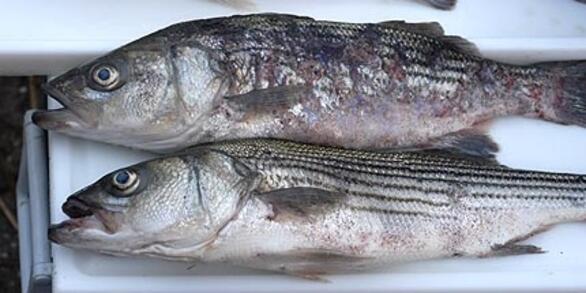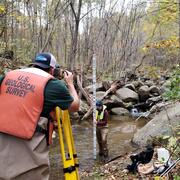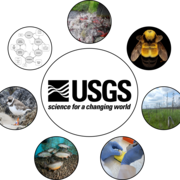Fish and Aquatic Species Conservation
Fish and Aquatic Species Conservation
At the Eastern Ecological Science Center (EESC), we strive to provide world-class science to inform natural resource decisions that preserve and enhance our quality of life.
Filter Total Items: 89
Using monitoring data to measure conditions over time in Chesapeake Bay streams
This study provides a comprehensive assessment of the health of streams throughout the Chesapeake Bay. Monitoring data were used to assess seven key indicators of stream condition, revealing consistent patterns of degradation in urban and agricultural areas. The findings offer critical insights that can inform watershed restoration efforts and improve long-term monitoring strategies.
EESC Makes an Impact: Enhancing Recreational & Commercial Fishing
The USGS Eastern Ecological Science Center (EESC) provides world-class science to inform natural resource decisions on aquatic ecosystems, species populations and management, disease, and invasive species. Our scientific products represent critical contributions that enhance the ecological and economic sustainability of recreational and commercial fishing. In the United States, anglers contribute...
EESC Makes an Impact
The U.S. Geological Survey Eastern Ecological Science Center (EESC) strives to provide world-class science to inform natural resource decisions that preserve and enhance our quality of life. We work directly with managers of our shared natural resources to provide the unbiased scientific tools, research and innovations needed to make informed decisions in today’s complex and rapidly changing...
Key Values of a Century of EESC Science
The USGS Eastern Ecological Science Center (EESC) is rooted in a proud tradition of service to the nation—advancing science that informs the conservation and management of fish, wildlife, and habitats across the eastern United States and beyond. Our mission is clear: deliver reliable, partner-driven science that supports natural resource decisions today, while ensuring these resources remain...
Life History and Migration of Sturgeons in New England Waters
Sturgeons appear in the fossil record as early as the Triassic, 200 million years ago. Although most populations could once tolerate harvesting pressures, most populations have collapsed and nearly all of the 28 species alive today are listed as threatened or endangered. In New England, dams and water regulation challenge population recoveries of the two resident species, the shortnose and...
EESC Makes an Impact: Reducing Management Costs and Increasing Efficiency
Decision analysis is widely used in business applications to improve cost saving and increase efficiency under uncertainty. Scientists at the U.S. Geological Survey Eastern Ecological Science Center (EESC) include world-renowned experts who use data, mathematics, statistics, and computer science to help frame and solve decision problems to support U.S. national security, public health, wildlife...
Genomics to Aid Conservation and restoration of the Yellow Lampmussel (Lampsilis cariosa) and Tidewater Mucket (Atlanticoncha ochracea)
Due to the rapid decline in abundance of Yellow Lampmussel ( Lampsilis cariosa) and Tidewater Mucket ( Atlanticoncha ochracea), USGS and partners at the U.S. Fish and Wildlife Service (USFWS) and Central Michigan University (CMU) are conducting an assessment of genetic diversity and population structure to inform appropriate recommendations for conservation and management of each species. These...
Population Monitoring and Removal Strategies for Blue Catfish (Ictalurus furcatus) in Chesapeake Bay
USGS is helping with the design of a population survey and developing mathematical models to assess potential activities to manage the population of invasive blue catfish ( Ictalurus furcatus) in the Chesapeake Bay. This research will help managers determine the cost and feasibility of approaches to control this invasive species.
Alosine Genetic Stock Identification and Tissue Repository
American Shad ( Alosa sapidissima), Blueback Herring ( Alosa aestivalis), and Alewife ( Alosa pseudoharengus; collectively “alosines”) once supported large fisheries along the U.S. Atlantic Coast. However, impassable migration barriers, declines in habitat quality, and exploitation have led to declines in many spawning populations. Substantial resources have been invested to support the recovery...
Sturgeon Occurrence and Behavior in the Outer Continental Shelf
A new study aims to collect information on sturgeon temporal and spatial distribution to inform offshore wind energy and sand leasing operations.
Supporting Interstate Conservation of Atlantic Sturgeon (Acipenser o. oxyrinchus) Using Genetics, Telemetry, and Side-scan Sonar
USGS scientists are using innovative combinations of telemetry, genetics, and side-scan Sonar to support conservation of endangered Atlantic sturgeon ( Acipenser o. oxyrinchus).
Conservation Genetics of American Shad (Alosa sapidissima) and River Herring (Alosa aestivalis and Alosa pseudoharengus)
USGS scientists are studying American shad ( Alosa sapidissima), blueback herring ( Alosa aestivalis), and alewife ( Alosa pseudoharengus; collectively “alosines”) to develop robust genetic baselines that will inform management practices for individual species.















